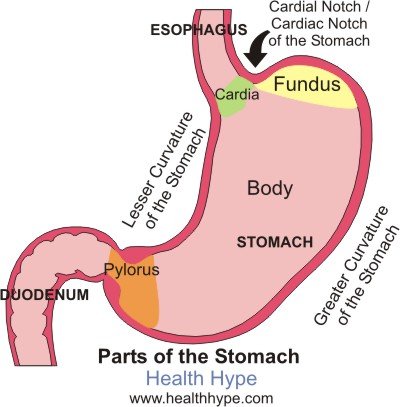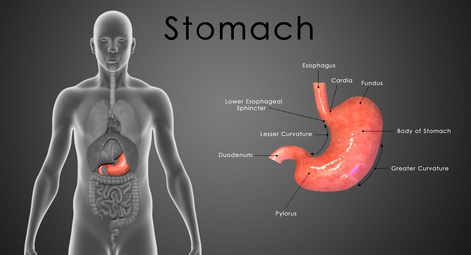Normal and Delayed Gastric Empting (Slow Stomach)
Gastric emptying is the process by which the stomach empties its contents into the duodenum of the small intestine for further digestion of food and absorption of nutrients. While this may seem like a simple process, it is carefully coordinated so as not to overwhelm the duodenum with large amounts of partially digested food mixed with the acidic gastric secretions, which is collectively known as chyme.

Normal Gastric Emptying Process
The stomach is a muscular, hollow organ. When food enters the stomach, it is churned by the stomach contractions (peristalsis) with gastric secretions (refer to Gastric Acid Secretion) and this allows for both mechanical and chemical digestion. Most of this churning occurs within the body of the stomach where the muscle contractions are weak.
The contractions lower down the stomach, near the pylorus, are more intense. This pushes the more fluid chyme through the pylorus while undigested food particles are forced higher up into the stomach for further breakdown. These stronger peristaltic waves that occur near the pylorus propel the fluid chyme through the pylorus into the duodenum in a pump-like action. This is referred to as the ‘pyloric pump‘.
The distal part of pylorus has a thick muscular wall arranged in a circular manner which remains contracted in a normal state. This is known as the pyloric sphincter. Even though it is contracted, the sphincter is not totally closed and there is gap which allows fluids like water or chyme to move through into the duodenum but prevents the movement of larger food particles.
Causes of Normal Gastric Emptying
The vagus nerve is mainly responsible for parasympathetic stimulation to the stomach. This increases peristalsis and opens the pyloric sphincter. Sympathetic stimulation via the celiac plexus inhibits peristalsis and the opening of the sphincter. This is influenced by brain stem as well as stimuli from the sensory nerve endings in the gastric epithelium. Refer to Stomach Nerves for more information on the stomach nerve supply.
Certain local factors within the stomach and duodenum promote the pumping of chyme through the pyloric sphincter and decreases the tone of the sphincter muscles, thereby widening the opening. The local factors within the stomach that promote gastric emptying are relatively weak compared to the control exerted by the duodenum. Stretching of the stomach wall and the hormone gastrin increases the activity of the pyloric pump. Since gastrin secretion is increased by the presence of certain foods in the stomach, this can also be seen as a factor for increasing the activity of the pyloric pump.
A more potent mechanism of controlling gastric emptying is from the inhibitory effect of the enteric reflexes originating from the duodenum. These inhibitory reflexes slow down gastric emptying and are dependent on :
- Acidity of intestinal chyme
- Distension of the duodenal wall
- Irritation of the mucosal lining of the duodenum
- Concentration of the intestinal chyme
- Certain foods, like the breakdown products of protein and fat
Apart from the nervous reflexes that inhibit gastric emptying, certain hormones also play a part in gastric emptying. The hormone that plays the biggest role is cholecystokinin (CCK) and to a lesser degree, gastric inhibitory polypeptide (GIP) is involved. These hormones are secreted by the duodenum and jejunum in response to certain foods in the lumen of the small intestine. Refer to Digestive Hormones for more information on triggers and actions of these hormones. CCK and GIP inhibit gastric emptying.
The greater the stimulation by the inhibitory reflexes and the greater the CCK and GIP secretion, the slower the rate of gastric emptying.

Slow Stomach Emptying
A slow stomach is a common term that is used to describe delayed gastric emptying. This means that the contents of the stomach are not released into the duodenum at a normal rate. It may be related to a disorder with the :
- stomach nerves and neurotransmitters
- digestive hormones
- smooth muscle of the stomach wall
- mechanical obstruction
Gastroparesis is delayed gastric emptying with no mechanical obstruction to the flow of gastric contents. Gastric outlet obstruction on the other hand is when there is a mechanical obstruction to the flow of gastric contents out of the stomach.
Causes of Delayed Gastric Emptying
Gastroparesis
Causes of gastroparesis include :
- Diabetic neuropathy
- Anorexia nervosa and bulimia (refer to Effects of Eating Disorders)
- GERD (gastroesophageal reflux disease)
- Hypothyroidism
- Sclerodoma
- Amyloidosis of the gastric musculature
- Parkinson’s disease
- Viral infections
- Surgery affecting the vagus nerve
- Chemotherapy
- Drugs
- Opiates
- Calcium channel antagonists
- Anticholinergics like tricyclic antidepressants and phenothiazines
Gastric Outlet Obstruction
The mechanical obstruction may lie in the duodenum or within the pyloric channel (intrinsic). Any mass outside of the organs surrounding the stomach and duodenum may also cause an obstruction to the flow of chyme (extrinsic).
Causes of gastric outlet obstruction include :
- Pyloric edema due to gastritis or peptic ulcer
- Pyloric stenosis
- Fibrotic stricture of duodenal ulcer
- Adult hypertrophic pyloric stenosis
- Gastric polyps
- Cancer
- pancreas
- stomach
- duodenum
- bile ducts (cholangiocarcinoma)
- Congenital duodenal webs
- Pancreatic pseudocysts
- Gallstone obstruction
Signs and Symptoms
The signs and symptoms of delayed gastric emptying, whether due to a mechanical obstruction (gastric outlet obstruction) or stomach nerve and muscle disorders (gastroparesis), may be of a sudden or gradual onset.
Any disruption in normal gastric emptying causes a build up of undigested food, partially digested food particles, and chyme. Further eating or drinking may cause a backflow resulting in nausea and vomiting. The fairly ‘stagnant’ gastric contents are prone to bacterial overgrowth within the stomach resulting in fermentation of food. Partially digested food can coalesce and harden into solid masses known as bezoars. This can cause further obstruction of the pyloric canal.
Gastroparesis and gastric outlet obstruction are usually of a gradual onset. However, gastroparesis due to vagal nerve damage after surgery may result in the sudden onset of the signs and symptoms of delayed gastric emptying. The most severe symptoms may be noted in complete gastric outlet obstruction which is rare unless the condition has been left untreated for a prolonged period of time.
Since gastroparesis and gastric outlet obstruction occur secondary to an underlying disorder, the clinical presentation may vary depending on the cause.
The common signs and symptoms of delayed gastric emptying includes :
- Nausea
- Vomiting – severe projectile vomiting may indicate a complete obstruction
- Abdominal distension
- Bloating (feeling of fullness even after a small meal or few bites of food)
- Early satiety
- Heartburn (gastroesophageal reflux, acid reflux)
- Excessive belching
- Lack of appetite
- Unintentional weight loss
- Gastric pain – upper middle abdominal pain, left upper abdominal pain
- Fluctuation in blood glucose levels – high and low blood sugar
- Stomach cramps
- Signs of vitamin deficiencies as a result of malabsorption
- Offensive odor of the breath (halitosis) and burps (sulfur burps) as a result of bacterial overgrowth
- Altered bowel movements may be noticed, particularly constipation
- Dehydration, especially if there is constant vomiting
References
- Gastric Empting Study. Children’s Hospital of Pittsburgh
- Gastrointestinal Motility and Physiology. UC San Diego
Last updated on August 31, 2018.





